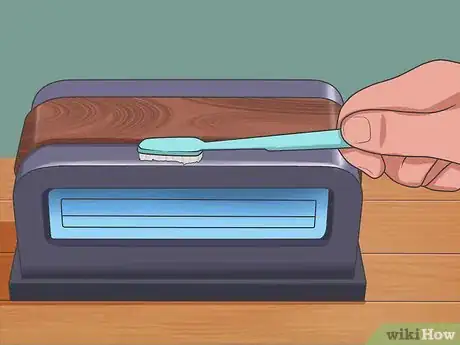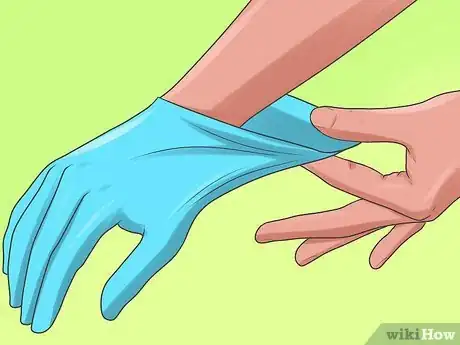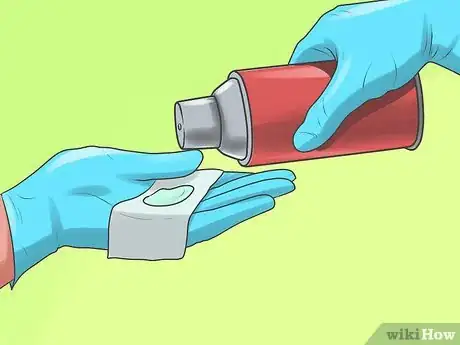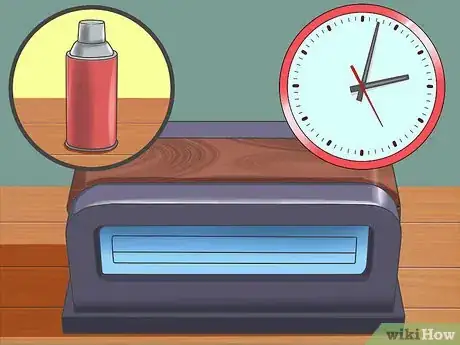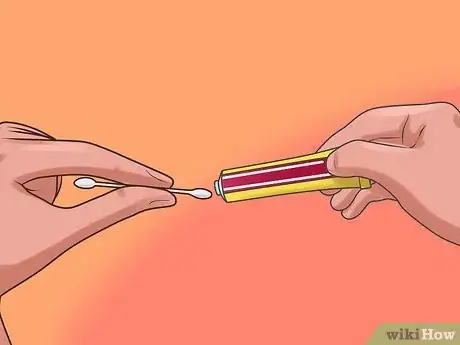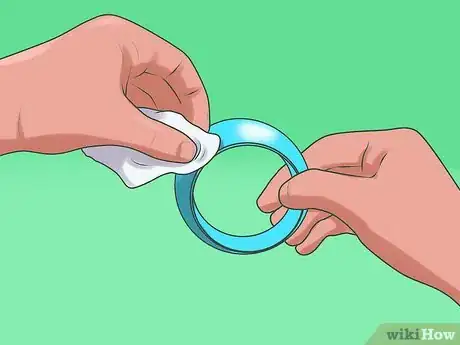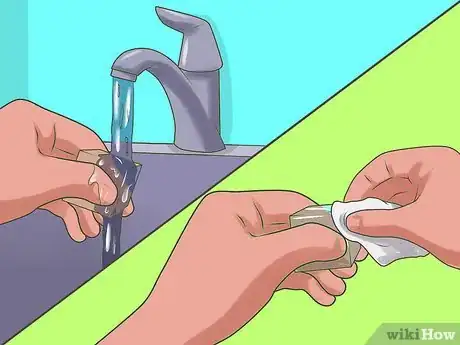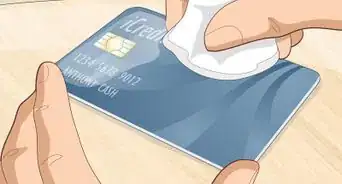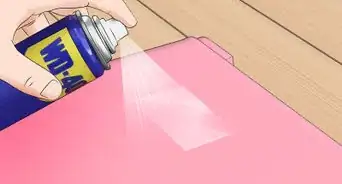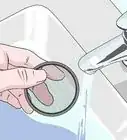This article was co-authored by Alessandra Mendes. Alessandra Mendes is a Cleaning Specialist and the Founder of Cleaning Glow. With ten years of experience, Alessandra and her team specialize in providing residential cleaning services in the San Francisco Bay Area. All members of the Cleaning Glow team have completed thorough background checks.
There are 10 references cited in this article, which can be found at the bottom of the page.
wikiHow marks an article as reader-approved once it receives enough positive feedback. In this case, 100% of readers who voted found the article helpful, earning it our reader-approved status.
This article has been viewed 163,511 times.
Bakelite is a synthetic plastic resin first produced over a century ago, and used in thousands of applications. Nowadays, Bakelite has been replaced by more modern plastics, and may be the first plastic to achieve vintage status. While tough, Bakelite will develop a hazy or dull finish when exposed to the elements. Specialized products are required to clean it safely and effectively, but the restored shine will last for many years if the Bakelite is kept out of direct sunlight.
Steps
Cleaning and Polishing Bakelite
-
1Rub off dirt and dust. If there is dirt or dust on your Bakelite, clean it off by rubbing with a dry cloth. Use a dry toothbrush to reach small crevices, grooves, and cracks.
- If you are not 100% certain the material is Bakelite, use the methods in the identification section to confirm it before continuing. If you have a strong nose, you might notice a diagnostic smell while rubbing the plastic.
-
2Select a cleaning product. There are several products commonly used to clean Bakelite. While these are often specialized and more expensive than general purpose cleaners, using one of the following is highly recommended. Bakelite requires a slightly abrasive cleaner to remove the deteriorated surface material, but can be permanently ruined if an overly abrasive cleaner eats through to the pulpy filler material inside.[1]
- Use Magnolia Glayzit or Soft Scrub for slightly faded Bakelite.
- Use Brasso, Novus plastic polish, Simichrome metal polish, or an automobile rubbing compound to treat more severe fading and/or light scratches.[2] Brasso is usually the cheapest, but may require more elbow grease.
Advertisement -
3Follow the safety instructions for your product. It's usually a good idea to wear gloves and work in an area with good ventilation. The warning label on the product you chose will provide more specific information.
-
4Rub the product on with a cloth. Put a dollop of the cleaning product onto a clean, soft cloth. Rub it over the surface of the Bakelite in circular motions. You might notice some improvement immediately, but you do not need to achieve a fully restored shine in this step. Add more of the product onto the cloth whenever necessary.
- Do not apply a lot of pressure to Bakelite objects, especially if they are scratched or cracked, or you may wear through the outer surface and into the pulpy (and potentially toxic) filler material.
- Catalin objects, which includes most "Bakelite" jewelry and brightly colored Bakelite, do not have filler material and can be scrubbed as hard as you like.
-
5
-
6Buff the Bakelite with a dry cloth. Use another clean, dry cloth to buff the Bakelite material until the excess cleaning product is removed and a shiny surface is left behind. Do this regardless of the cleaning product you chose.
- If necessary, repeat with another layer of cleaning product.
-
7Use last resort methods. If several applications of the cleaning product fail to restore the shine or repair damage from scratches, you can use one of the following methods restore protection and an attractive appearance to the Bakelite. This is only recommended as a last resort, due to the possibility of damage:
- Use a high speed cloth buffing wheel to lightly smooth the surface. Overuse can permanently remove the Bakelite's outer surface.
- Or very lightly and evenly sand the Bakelite with finest grit sandpaper you can find (1000 grit or above). Once sanded, apply the cleaning product again, or cover the surface with paint.[5] Again, over-sanding or using coarse sandpaper can permanently damage the Bakelite.
Identifying and Cleaning Early Plastics
-
1Run the item under hot tap water for 15–30 seconds. This will cause many early plastics to release a distinct smell. This step is not recommended for broken items, or items with delicate non-plastic attachments. If the item is dirty, rub it with a cloth first to remove the dirt. If you have a sensitive nose, you may notice the smell simply from rubbing.
- A smell of formaldehyde means the plastic is Bakelite or Catalin. You might recognize the smell from preserved animal specimens in biology labs.[6]
- A rotten milk smell comes from Galalith (French Bakelite).
- Camphor smell (a pungent evergreen or old-fashioned mothball odor), comes from celluloid.
- If there is no smell, it is probably Lucite, but could be a different plastic protected by a finish or paint.
- If the smell doesn't match any of the above descriptions, it's possible the piece is a modern "Fakelite" imitation product.
-
2Rub with a test chemical. Use this method if the hot water test was inconclusive. You may use Simichrome, which can also be used for polishing, or Formula 409, which can cause damage but is a more accurate test.[7] Either way, take a tiny dab of the material with a cotton swab, and rub it against an inconspicuous corner of the plastic that has been dried and rubbed clean of dirt. If the cotton swab comes away yellow or yellow-brown, the material is probably Bakelite.[8] Otherwise, you may need to take it to an antique shop for identification.
- Wash off the material with mild soap and water, then dry immediately.
- Some black Bakelite objects, or Bakelite that has been recently re-worked, may not respond to this test.
-
3Treat Bakelite and Catalin as described in other sections. Catalin is essentially the same material as Bakelite, and can be cleaned and polished using the same methods. In fact, since Catalin does not contain the pulpy "filler" materials used in Bakelite production, it can generally stand up better to slightly abrasive treatments, such as metal polish or sanding.[9] If your object could use a stronger polish, check whether it is Catalin using these guidelines:
- Catalin was often produced in bright colors. Bakelite is usually brown or black unless it has been painted, but there are exceptions.[10]
- Most "Bakelite" jewelry is actually made from Catalin.
-
4Dry and clean celluloid. Celluloid is the only common early plastic that can be damaged by water, but if you dry it immediately after the water test, it will likely be unharmed. Use a soft cotton cloth or swab to dry the plastic, since celluloid can be easily scratched. A barely dampened cotton swab can remove small spots of discoloration, if dried immediately afterward, but further cleaning and repair may require an expert.[11]
-
5Clean Galalith. Galalith is a white, glossy plastic made from milk casein and formaldehyde. Dust it with a soft cloth, but avoid using chemical cleaners. If it is severely scratched, take it to an antique expert for repair.
-
6Clean Lucite. First, rinse or scrub off dirt on the lucite surface. Use plastic polish to buff or repair scratches in this clear, acrylic plastic. To repair severe damage, you may need to use a polishing wheel.
- Novus brand plastic polish is likely the best-known. Use Novus 1 for buffing, Novus 2 for light to moderate scratches, and Novus 3 for deep scratches.
Expert Q&A
-
QuestionHow do you make Bakelite look new?
 Alessandra MendesAlessandra Mendes is a Cleaning Specialist and the Founder of Cleaning Glow. With ten years of experience, Alessandra and her team specialize in providing residential cleaning services in the San Francisco Bay Area. All members of the Cleaning Glow team have completed thorough background checks.
Alessandra MendesAlessandra Mendes is a Cleaning Specialist and the Founder of Cleaning Glow. With ten years of experience, Alessandra and her team specialize in providing residential cleaning services in the San Francisco Bay Area. All members of the Cleaning Glow team have completed thorough background checks.
Cleaning Specialist You’ll need to purchase a liquid metal cleaning polish. Apply the cleaner to the Bakelite using a soft cloth, covering the whole thing. Wait for it to dry, then buff it until shiny to remove the product layer.
You’ll need to purchase a liquid metal cleaning polish. Apply the cleaner to the Bakelite using a soft cloth, covering the whole thing. Wait for it to dry, then buff it until shiny to remove the product layer. -
QuestionThe handle on my old revolver is probably bakelite. It smells like vomit, and I would like to get rid of the odor.
 T. ChinsenTop AnswererBaking soda is effective in removing odor. It is generally placed next to the item with odor within a container that can be closed to provide an airtight seal. It is the equivalent of a box of baking soda in the fridge to capture odors. Another method is to wrap the item in a layer or two of clean white newsprint. Do not use newspaper as the ink can transfer onto plastic. Again, place the wrapped item into an airtight container. Use a gallon-size freezer bag if no container is available. It may take a couple of weeks for the odor to dissipate. Change the paper if the odor is still evident after two weeks.
T. ChinsenTop AnswererBaking soda is effective in removing odor. It is generally placed next to the item with odor within a container that can be closed to provide an airtight seal. It is the equivalent of a box of baking soda in the fridge to capture odors. Another method is to wrap the item in a layer or two of clean white newsprint. Do not use newspaper as the ink can transfer onto plastic. Again, place the wrapped item into an airtight container. Use a gallon-size freezer bag if no container is available. It may take a couple of weeks for the odor to dissipate. Change the paper if the odor is still evident after two weeks.
Warnings
- Do not use the hot needle test or other harmful tests to identify plastic. Even if the test does not harm Bakelite, many similar plastics could melt or burn.⧼thumbs_response⧽
Things You'll Need
- Liquid metal polish (or other cleaning product – see instructions)
- Several clean cloths
- Small toothbrush
- Cotton swabs
References
- ↑ https://www.youtube.com/watch?v=V5ezGXM4ZT4
- ↑ http://www.britishtelephones.com/bakelit1.htm
- ↑ https://www.youtube.com/watch?v=V5ezGXM4ZT4
- ↑ http://www.delviesplastics.com/Novus_Directions.html
- ↑ https://www.youtube.com/watch?v=V5ezGXM4ZT4
- ↑ http://www.worldint.com/science/bakelite.html
- ↑ http://www.plasticfantastic.com/testing.html
- ↑ http://www.elvenkrafte.com/bakelite%20presentation.htm
- ↑ http://www.thefedoralounge.com/showthread.php?20979-Bakelite-Advice
About This Article
To clean Bakelite, start by using a dry cloth to remove any dirt or dust from the surface, and a dry toothbrush to reach small cracks and crevices. Then, put a small dollop of a specialized cleaning product, like Soft Scrub or Brasso, on a clean, soft cloth. Next, rub the cloth over the surface in circular motions. Finally, buff the Bakelite with another clean cloth to give it a nice shine. For more tips, including how to restore your Bakelite if cleaning products aren’t doing the trick, scroll down!
